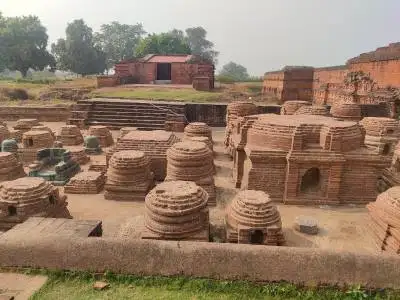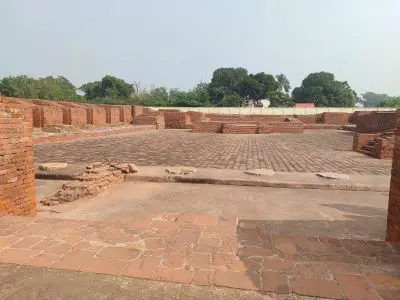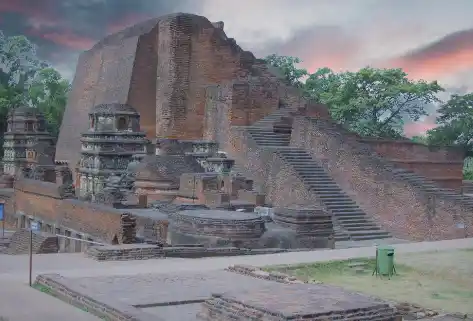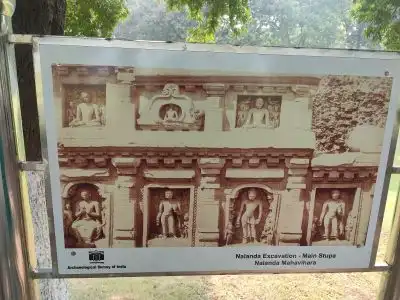Introduction
Nalanda was the first most ancient Buddhist university or Mahavira in history of India located about 95 km southeast of Patna in Bihar where people from all around the world came to this center of learning to gain the ocean of knowledge from highly regarded acharyas and professors .
Nalanda is prominently mentioned in the early work of Jaina and Buddha literature. According to Jaina literature, Nalanda was a prosperous place where Mahavira spent his 14 chaturmas ( Holy period of 4 months ). Pali Buddhist literature also contain many references regarding Nalanda.
This ancient university was founded by Kumargupta I in the 5th century CE ( 415 AD -416 A.D ) and was once the epic center of learning but in 12th century, it turned into ashes after the barbaric attack and the burning of the ancient Mahavira by the Islamic invader Bakhtiyar Khilji .
There were around 9 million books in the Nalanda university which were written and studied by the students of the university. Some historians claimed that the library of the university was that much vast and expanded part of the university that it took more than 3 months to burn .
This ancient center of learning was the world’s first Buddhist residential university where students from all around the world came and studied their for free in the monastery . The university had around 30,000 monks and nearly 2000 Acharyas and professors . It attracted students from China , Tibet , Greece and Persia . The numbers must had been increased later .
Dalai Lama has stated ” The source of all Buddhist knowledge has came from Nalanda ” . During the collapse of the university , few monks saved their lives by taking the shelter in Tibet . Those monks spread the knowledge of Buddhism there and made it a center of Buddhism for the world .
After seeing the ruins of Nalanda University one must have thought How was Nalanda University born ? Who founded this ancient university and how it became world famous ? The history of Nalanda university will definitely going to give you the sense of understanding about the education system and their great architect design . This article will answer all your questions which are running in your mind.
In 2006 , a joint announcement was done by some collective Asian nations to make this ancient university as Nalanda International university but after 17 years of that announcement , now on 19th June 2024 ,the new magnificent university of Nalanda is getting revived . Though the ruins of Nalanda university came under UNESCO world heritage site, it needs to stand up again and rebuilt the site by taking many initiatives .
To establish an University like Nalanda university , a society must have to be strong and literary passionated and wealthy too .
A deep understanding of every sect and also have that much revenue to establish the grand University . Another things required are prosperity , good governancy , peace , patronised artists, poets, philosophers etc . The King and the capable people of the kingdom of Kumargupta I had the abilities to turn a dream into a reality .
In the early 5th century King Kumargupta I (Sakraditya ) who was a devout Hindu put the foundation of the great Nalanda University .
Nalanda region had been famous for Buddhistic world long before the University came into existence . But after the establishment of great ancient Nalanda university , the whole world came to know and became the true seeker of Buddhism .

People who are unaware of the great Indian history must have been surprised to know that the world’s best university was established in India in the 5th century which came after Takshashila university .
The aim of the education in the university was the spiritual advancement of the students and not just about materialistic gain or achievements .
When you have this spiritual advancement through Dharma , your external work automatically get uplifted to the highest possibility whether it’s work of arts ,science, medicines, business or anything else.
Background of Nalanda university
The grounds of the establishment of the monastery were originally a mango Park ( called as Pavarika) which were purchased by 500 merchants for 10 Koti of gold coins . They happily presented it to Buddha. And from here, the story of the formation of Vihar started. This was the place where Buddha had preached the law for 3 months to his disciples.
According to I – tsing, this place was once the happy great residence of the holy Serpent . Nalanda was the name of a holy serpent and from here, the place got the name Nalanda.
According to Tibetan Buddhist, Taranatha, Ashoka, the great mauryan emperor of 3rd Century BCE gave offering to the chaitya of Sariputra ( disciple of Buddha) that existed at Nalanda and there he erected a temple.
Nalanda University founder
According to Bilsad stone pillar Inscription, Nalanda university was founded by Kumaragupta I of the Imperial Gupta dyansty ( Sakraditya ) in 415 AD -416 A.D “ As per the inscription it appears that Kumargupta I was a saivite ( devotee of Shiva ) when he ascended the throne but later on in 448 AD – 449 AD , he adopted Buddhism as his religion which is clear from ” Mankuwar stone ” inscription .

\Nalanda was first founded by Kumargupta in the 5th century AD which later on continued by his son and other several kings like Tathagata Gupta raja ,Vajra , king Harshvardhan ( 7th century AD ) , Pala ( 8th – 12th century ) .
- The formation of Sangharama was the starting point of the university which was done by Kumaragupta I . Kumaragupta’s son continued the work of his father. He built another Sangharama to the south .
- King Tathagata Gupta raja built to east from this another Sangharama .
- Baladitya built a Sangharama on the North East side and he also built a great Vihara which was around 300 feet in height . Vihara is a place where Buddhists live and this is how Bihar got its name .
- Vajra built the Sangharama on the west side . A long succession of kings continued the work of building the Nalanda University with all their skills and sculptor concept till the time it stood as a great University.
- Harshvardhan of Kannauj who was the king of Central India also played an important role in building the Sangharama . There were numerous students and professors or Pandits who were in the university that needed to be taken care of . The king Harshvardhan provided food and raiment for them and also took the charge of feeding around 40 priests everyday.
- Malada ,a minister of king Yasovarmmadeva, made various kinds of offerings to the Nalanda monks , paid for their daily food and donated money equal to the price of the whole Nalanda Institution . There were not many details of Yasovarmmadeva that had been found in the Inscription discovered in Nalanda . He reigned from 728 – 745 A.D and had made Kanauj his capital .
- The middle of the 8th century brought Palas who emerged in Bengal . Gopala Was the first king who acquired the Throne of Pala but didn’t do anything for Nalanda but his son Dharmpaladeva did great service to the Nalanda University .
- Devpaladeva granted five villages named Nandivanaka , Manivataka , Natika , Hasti , Palamaka Towards the income for the blessed Lord Buddha for the offering, Shelter , garment and for the repair of the monastery when damaged .
- Govind Pala Dev was perhaps the last king who had patronised Nalanda because in 1197 A.D. he died by the violent storm of Islamic invaders and finally Nalanda University was destroyed into ashes by Bakhtiyar Khilji .
- One Stupa which was found in Nalanda referred to Mahendrapal Deva .
Many of the inscriptions were destroyed by Bakhtiyar Khilji which made it unable to give a continued and unbroken history of Nalanda University and its patrons .

History of Nalanda university
One of the most secret mystery of the Nalanda university is the prophecy done by a soothsayer about the destruction of the university the way a Naga was wounded during the establishment of the great Nalanda mahavihara .
When the place was selected to raise the university and laying the foundation was going on , the Naga was wounded severely . Surrounded with fears , king Kumargupta called an eminent soothsayer and asked him whether to proceed with the work or not .
The soothsayer responded that this is a very superior site and added that it will become highly renowned for thousands of years and will flourish continuously . Students from all parts of land will come here to gain knowledge and it would have an international reputation but will finally suffer with much blood because of this wound given to the Nagas .
The prophecy of the soothsayer became true . Nalanda had become a battlefield in the 12th century (by Islamic invader Bakhtiyar Khilji ) where two faiths of opposite characters fought with each other and finally destroyed the whole Nalanda University after which it never stood up again . Now let us focus on the rise of Nalanda University.
Ancient Nalanda University library
Before framing such a big University there is a need to have literature in such a simplified sense so that a layman can understand it properly .There were many Gurus and Pandits in Nalanda who had written vast literature explaining about anushasan ,Nyaya, tantra etc .
According to Tibetan accounts, the quarter in which the Nalanda University , with its grand library was located , was called Dharmaganja . It comprised of three magnificent buildings called Ratnodadhi, Ratnasagara and Ratnaranjaka. Ratnodadhi was a nine- storied building which had the collection of Sacred scripts called Pranjnaparamita-Sutra and Tantrik works such as Samajaguhya etc.
Learning in ancient Nalanda university
According to I-tsing , in the beginning as a student, Siddham was taught which was followed by Sutra , Dhatu and Khila.
I – tsing’s account further describes the study of Kasika-vrtti. Students also learnt Hetuvidya ( logic) , abhidharmakosa( metaphysics). By learning Nyayadvarataraka-sastra, they rightly draw inferences (anumana) . By studying the Jatakamala, their powers of comprehension increased.
Nalanda University had made theology a compulsory subject for all the students .Theology basically meant complete grip on the works of Mahayana .
Unique way to convey the teachings of the University was through the composition of encyclopaedical works which were Dealing with theology , Philosophy , logic , grammar etc . One such work was Tattvasangraha .
Nalanda University was formed with great efforts of Buddhist and non- buddhists people . Hindu scripture like Vedas ,Vedanta ,Sankhya ,Vaisesika and many others were the forms of education in Nalanda .Buddhism gives the teachings of Majjihima Nikaya , Sutta Pitaka and many others forms of education . Mentioning below some more form of education :
- Anusasan
- Sarpavidya
- Itihasa – Purana
- Gatha
- Rasi ( Science of numbers or arithmetic )
- Bhuta Vidya ( Art of controlling )
- Dev Vidya ( Science of worship of God and goddess )
- Ksatra Vidya
- Vyakarana ( Grammar )
The development of Buddhist philosophy started with the discovery of “ Prajnaparamita “ and having the philosophical commentaries by people like Nagarjuna .
“ Mahayana “ was popularised by Nagarjuna and Aryadeva which gives a deeper meaning to what Buddha preached during his lifetime . And finally gave it the philosophical name “ Madhyamika “ . Asanga and Vasubandhu too made a valuable contribution to the development of Buddhist philosophy .
Buddhism was at its peak level by the 4th century AD and many philosophical ideas were generated which made it a right time to raise a University .
Famous students and High -Priest of Nalanda
According to Taranatha, Tibetan Buddhist, Nagarjuna who was a famous Mahayana philosopher and alchemist of around second century A. D. , studied at Nalanda University and later on became the high priest there.
Asanga, a Buddhist philosopher of the yogacharya school of the 5th century A. D. had spent 12 years of his life in Nalanda. His brother Vasubandhu became the high Priest at Nalanda.
Hiuen Tsang, a student of Nalanda who comprehensively described the university in his account (one of the most reliable sources ), had received an Indian name , Mokshadeva while residing in Nalanda.

Other great students and priests were Dharmapala, Silabhadra ( head of Nalanda university and author of multiple sutras), Dharmakirti (successor of Silabhadra) , Santarakshita.
Suvishnu, a Brahman contemporary of Nagarjuna had built around 108 temples to prevent the declination of Hinayana and Mahayana schools of Buddhism.
Some other great pandits or Acharyas of the Nalanda University were
- Dinnaga
- Candrakirti
- Candrogomin
- Dharamkirti
Cadrogomin had written more than 60 books . Some of them are Simhanada Sadhana , Mahakarunika Stotra , Raksacakra ,Abhicara karman . He was also well versed in logic , fine arts , tantra , Science of medicine .

The Pandit of Nalanda used to perform the religious and monastic practices daily as prescribed by Buddha with great enthusiasm . The word Pandit was a prestigious title conferred to distinctive teachers or Professors of the University .
Admission in Nalanda university
In the old Nalanda university, there was a systematic way to get admission in the vishwavidyalya.
- Before taking admission one must had the in-depth knowledge of vedas ,upanishad , work of different branches like samkhya , Vaisesika , Nyaya and also having the proper knowledge of Mahayana and Hinayana Buddhism .
- Scholars had to go through a strict test of their knowledge which would be conducted by none other than the gatekeepers of the university .
- These gate keepers of the university were very learned men . Anyone who wanted to get admission in the university had to go into the discussion with the gatekeepers and the gatekeepers put very hard questions which were difficult to answer . Only if he was pleased with the answer, would one get admission .
Daily routine in ancient Nalanda University
- Every morning , the sound of the Ghanti (bell ) echoed in the University to remind priests of their bathing hour .
- Priests thousands in number moved towards the great pool of water to take bath . Only after bathing , the rites in Nalanda began to perform .
- Then the consecration of the holy image of Buddha took place and was then wiped with a clean white cloth and finally set up into the temple where flowers were furnished .
- Caityavandana was performed daily in the afternoon or in the evening .
- Students of the University were required to perform the religious rites and worship of the images which they read in the books . The worship of images was a distinct feature of the Mahayana .
Contribution of Nalanda University
- Nalanda was the place where buddhist monk Sariputta born and died . He was the monk who was the right hand disciple of the Budhha . Inclination towards buddhism made it possible for Gupta emperors to establish such a vast mahavihara for the students .
- The first buddhist monastery in Tibet was made by the king Khri-sron-deu-tsan in 749 CE under the guidance of the great Nalanda monk and scholar Santarakshita . From the 8th century the Nalanda started to take active part in propagating buddhism in Tibetan area .
- Santaraksita had a great contribution to the development of logic in the 8th century while Kamalasila was a teacher at Nalanda of tantra and logic and he was the one who laid the roots of Tantric Buddhisim .
Architecture of the ancient Nalanda university
- Nalanda university was at least one mile long ( 1.6 km ) and half a mile broad . All stupas and monastic buildings were systematically arranged in rows .
- It had seven big halls and around 300 medium rooms for attaining lecture classes . It’s not a myth that the tops of the buildings of the university touched the clouds . It is confirmed from the Hwui Li’s statement and also from the contemporary records . This make it clear that the buildings of the university must have majestic and spectacular height .
- There were multiple impressive ponds which were wholly covered with the blue lotuses . More than 13 monasteries which were for monk students . Each monastery was at least two storeys in height and comprised of both single seated and double seated rooms .
- There were multiple well constructed in the monasteries which indicates that this university was lavished with proper water supply . According to I-sting (675 AD ) who had stayed at Nalanda university for 10 years , the university had also received around 200 rich villages as endowment so that it could offer free boarding and cloths to its students .
- Most of the Sangharama were built in a row and these Sangharama or Vihara were about 3-4 storeys high .These all were mentioned in inscriptions which were found in Nalanda .
- Nalanda had temples to which were embedded with various jewels set which made these temples brilliant and grandeur .
- It had a massive library which was called Dharmaganja . It had three Grand buildings called Ratnasagara , Ratnodadhi and Ratnaranjaka .
- Ratnodadhi which was nine storeyed had a script called Prajnaparamita Sutra and also the tantric works too.
- All the Viharas , Sangharamas and libraries were surrounded by brick walls .
- One main gate opened into the Great College ,from there eight other separated halls standing in the middle of the Sangharama .

You may visit below article :
Vimana : The ancient Indian aircraft
Destruction of Nalanda university
The Nalanda university was destroyed by Bakhtiyar Khilji in 1193 A.D. The great university burnt for more than three months . The devastation of university and onslaught killing of buddhist monks and Brahmin scholars were so severe and scary that no one left to survive to explain the content of the books which were burnt .
Thousands of monks and Brahmin scholars were burnt alive , all books were put on fire , all monasteries were burnt so that nothing left to tell its history in future .
Around 9 million books were burnt which ultimately turned into ashes after three months of its burning by fanatic invader Bakhtiyar Khilji in the 12the century .
Bakhtiyar Khilji burnt Nalanda university because a Buddhist scholar of Ayurveda named Rahul Bhadra who treated and completely cured Bakhtiyar Khilji’s uncommon disease which was uncured by Hakim of his religion made him angry and agitated him from his core because a man from a different faith had more depth knowledge of curing the diseases . And this agitation made him to destroy and burnt the university.
According to Tibetan text, the Pag-Sam-Jon-Zang, after the destruction by the turks ( bakhtiyar Khilji) , the temples and chaityas where repaired by a Sage Mudit Bhadra.
Soon after this, Kukutasiddha, minister of the king of Magadha, created a temple at Nalanda, and, while a religious sermon was being delivered there, two very indigent Tirthika mendicants appeared. Some naughty young novice monks in disdain threw washing water on them. This made them very angry. After propitiating the sun for twelve years, they performed a yajna, fire-sacrifice, and threw living embers and ashes from the sacrificial pit into the Buddhist temples, etc. This produced a great conflagration which consumed Ratnodadhi. It is, however, said that many of the Buddhist scriptures were saved by water which leaked through the sacred volumes of Prajna-paramitasutra and Tantra.”
The university had been attacked two times before the attack of Bakhtiyar Khilji by the invaders the Gaudas in the 7th century and by the Huns ( central Asian community ) in between 455 AD – 470 AD . But the attack of Khilji was so severe and scary that it never recovered from this wound of destruction and finally ended up its journey in 1193 AD.
Buddha
It should be known to all that in early Buddhist art represented at Sanchi, Bharut, Bodh-Gaya, etc, Buddha was never portrayed in human form, his presence was being shown by a symbol or by an empty throne. Buddha’s images began to be erected under the foreign influence around the first century A. D. from North West India.

References :
- The University Of Nalanda ( author – Hasmukh D. Sankalia , Publication date : 1934 )
- Nalanda ( author – A . Ghosh , published by the director of archeological in India , fifth edition , 1965)
- Nalanda ( author – K . A. Nilakanta Sastri , 1941 , university of Madras )
Related Post which can provide knowledge about ancient India :
- Takshashila – World’s first most ancient Hindu University
- Bhaskaracharya : Great mathematician and astronomer of 12th century
- surrogacy and childbirth technology used in ancient India
FAQ ( Frequently asked questions )
